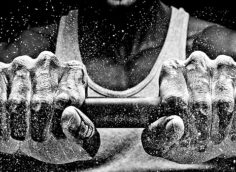The hip thrust may be the best glutes-builder on the planet. If you want to sprint faster, explode harder, rip more plates off the floor, and sport rock-hard gultes, the hip thrust should be part of your program.
But when Bret Contreras first introduced the hip thrust, a few thoughts ran through my mind:
- "Wow, that looks stupid! I'd be embarrassed to do that in public."
- "Even with a pad on the bar, that's still gotta hurt like hell. I bet it's one of those exercises like Zercher squats where guys try to act all tough and say it doesn't hurt when in reality it feels like your hip bones are getting crushed."
- "That looks like it might really put a lot of shear stress on the lumbar spine if you arch your lower back too much."
- "How the heck does that guy slide the bar up into position without crushing his junk?"
So I scorned the exercise for a few years and judged it as stupid – without ever trying it. That was a mistake.
I eventually broke down and decided to do it. After using it quite extensively for the last couple of years, I feel qualified to give my opinion.
Here are my thoughts:
- Hip thrusts fry the glutes in a way that's different (and more intense) than squats, deadlifts, and lunges. I feel my glutes working more during hip thrusts than any other exercise I've tried.
- If you're careful about form and use an appropriate weight, they're quite safe.
- With a good pad on your hips (I use an Airex pad), they really aren't uncomfortable at all – until the weight gets really heavy, when it can get uncomfortable on the hips even with a pad. Stronger lifters will be able to handle considerable loads after a bit of practice so this is something to consider, but for most people it's really not a big issue.
- For guys with bigger butts and thighs, it can be a real ordeal to slide the bar into position without hitting your tackle. Females tend to have an easier time getting into position, for obvious reasons.
- Because the exercise lends itself to using a lot of weight, much like deadlifts, it can be a real pain to load/unload the plates. This may not matter for some, but I abhor loading and unloading plates so much that this is somewhat of a deal-breaker for me. Call me lazy.
Looking at my thoughts about the exercise, my qualms really don't have to do with the exercise itself so much as the setup and logistics. With that in mind, to reap the benefits of hip thrusts without the annoying setup process, try Rack Hip Thrusts.
Normally you'll see people prop a bench against the outside of the power rack (so it won't slide backwards) with the barbell on the floor directly in front of the bench. Instead, try putting the bench on the inside of the power rack with the safety pins set about a foot or so off the ground, such that the plates hover just a few inches off the floor.

Those extra few inches are small enough that it still allows for a full range of motion when you do the exercise, but it really makes a world of difference in terms of ease of getting in and out of position. It also makes it exponentially less annoying to load and unload the plates.
And while women don't tend to have problems sliding the bar up their legs, this setup works well for those who aren't ready to hip thrust 135 pounds yet because it allows you to elevate the bar to a comfortable starting height even with small diameter plates.
For that reason, this has quickly become a huge hit with my female clients, and a lot of them are continuing to employ it even once they reach 135.
The pins also help serve as a depth gauge to ensure you come down far enough on each rep – similar to how you might use a box as a depth gauge for squats – and encourage you to control the eccentric portion of the rep to avoid slamming the bar off the pins.
Here's what it looks like action:
The rack method also works well for single-leg hip thrusts, which are my personal favorite because I feel it more in my glutes and the lighter loads are more comfortable on my hips.
The biggest problem most people have with single-leg barbell hip thrusts is just keeping the bar steady on their hips, especially in the bottom position. Doing them from the pins allows you to reset between reps, eliminating that problem.
Pausing each rep at the top helps a lot, too. I recommend this for bilateral hip thrusts as well because it forces you to pick a weight you can control and helps ensure that you use the glutes to lift the bar rather than skimping on the range of motion and/or substituting lumbar extension and anterior pelvic tilt for hip extension.
A quick word on getting the hang of single-leg barbell hip thrusts. Start with a very narrow stance so when you pick one leg up, the foot on the ground is more centered. That should help immensely.
This simple setup tweak will save you time and make your overall thrusting experience more positive. I just wish I'd started doing it sooner!
Thrust happy, my friends.





